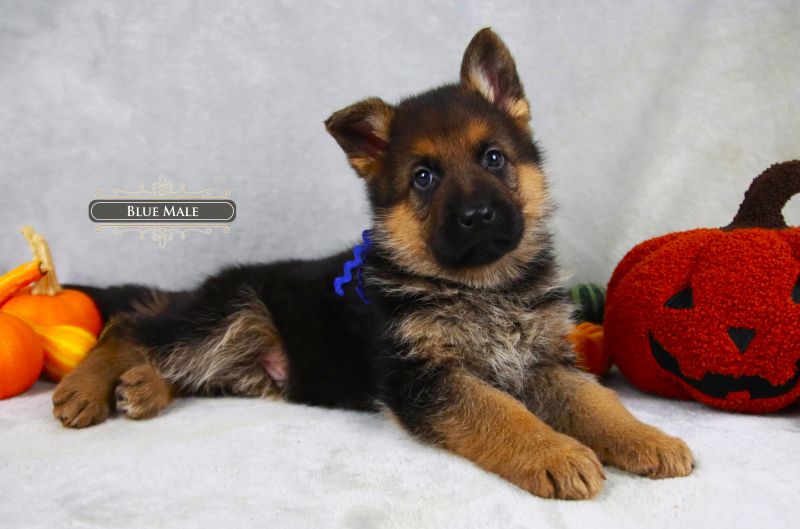Key Points:
German Shepherd dogs usually have six to ten puppies in a litter, though numbers can be smaller or larger. Age, health, genetics, and breeding conditions all influence the outcome. Over her lifetime, a female typically has four to six litters, with proper care and recovery between them. Preparation, good nutrition, and close monitoring of both mother and puppies give each litter the best start.

Bringing new puppies into the world is exciting, but it also raises a lot of practical questions. One of the first things people ask is, How many puppies does a German Shepherd have? The answer is not the same for every dog, and it depends on age, health, and breeding conditions.
Knowing what is typical gives you a better idea of what to expect, whether you are a breeder planning ahead or an owner curious about your dog’s future. Litter size matters because it affects how the mother should be cared for, how demanding the early weeks will be, and how each puppy’s growth is supported.
What Is The Average Size Of A German Shepherd Litter?
Many German Shepherd litters fall between six and ten puppies. That range is wide enough to cover what breeders and owners typically see, but it is not the whole story. Some females give birth to only a couple of puppies, while others can deliver twelve or more. These larger litters are less common, yet they show how much variation exists within the breed.
The middle of that range, which is around seven or eight puppies, is where many litters land. This is often considered the “average,” though every dog is different. A first-time mother may have fewer puppies, while later litters can produce more. Various factors play a role in this, which is why no two litters look exactly alike.
What Affects The Number Of Puppies?
Litter size is not random. Several elements come together to shape how many puppies a German Shepherd will have in one pregnancy. Some of these factors are within human control, while others depend on the dog’s natural limits.
Age Of The Mother
Young females in their first heat cycles often have smaller litters. As they reach their prime breeding years, litter sizes usually increase. Later in life, the number of puppies may decline again as fertility slows.
Health & Nutrition
The mother’s condition plays a major role. A balanced diet, proper weight, and regular veterinary care give her the best chance of carrying a healthy litter. On the other hand, poor health or malnutrition can limit the number of puppies and increase risks during pregnancy.
Genetics
Family history affects more than temperament and structure. Some bloodlines are known for producing larger litters, while others consistently run smaller. Responsible German Shepherd dog breeders track these patterns over time.
Breeding Conditions
Timing matters. If breeding takes place at the right point in the heat cycle, the chance of fertilizing more eggs is higher. Proper management of the breeding process ensures better outcomes for both the mother and her puppies.
Each of these factors can shift the outcome, but none guarantees a specific result. Even when everything is done correctly, there is always some natural variation. That is why breeders and owners prepare for a range rather than expecting an exact number.
How Many Puppies Does A German Shepherd Have In Her Lifetime?
A German Shepherd that is bred responsibly will usually have about four to six litters in her lifetime. That number is not fixed, but it reflects what most breeders consider safe and manageable for the mother. It’s important to remember that several factors affect how many litters a female can have.
Age is one of the biggest. Dogs that start breeding later will naturally have fewer litters, while those that begin earlier may have more. Health also plays a role. A strong, well-cared-for female may handle several pregnancies without issue, while another might be retired sooner if she shows signs that breeding is too demanding.
Recovery time matters as well. Breeders who space out litters give the mother time to regain strength, which can lead to healthier puppies and a longer breeding career. In the end, the goal is balance. The number of litters should match what the individual dog can handle comfortably, rather than aiming for a set total.
How To Care For The Mother & GSD Puppies
Raising a litter begins well before the puppies are born. The mother’s health, comfort, and environment all play a role in how smoothly things go. With the right preparation, you can give both her and the puppies the best chance to thrive.
- Veterinary care – Schedule prenatal visits to monitor the mother’s health and track the pregnancy.
- Nutrition – Provide a balanced diet that supports her increased needs as well as the growth of her puppies.
- Whelping area – Set up a clean, quiet, and comfortable space in advance so the mother feels secure during delivery.
- Post-birth monitoring – Weigh the puppies regularly and make sure each one is nursing well.
- Support for the mother – Ensure she has rest, proper food, and a calm environment while she recovers and cares for her litter.
Attention to these basics makes the process more manageable. By focusing on the mother’s well-being and keeping a close eye on the puppies, you create the foundation for a healthy start to life.
Common Myths About German Shepherd Litter Size
German Shepherd litters are often the subject of assumptions that sound convincing but don’t match reality. Here are some of the most common myths and why they don’t hold up.
Myth 1: First Litters Are Always Large
It’s easy to assume that a dog’s first pregnancy will produce a big litter, but that’s rarely the case. Many first litters are on the smaller side, sometimes only three or four puppies. As the female reaches maturity and her body adjusts to the demands of breeding, later litters often produce more. Expecting the first to be the largest can leave owners unprepared for fewer puppies.
Myth 2: Bigger Females Always Have Bigger Litters
Size alone doesn’t determine how many puppies a German Shepherd can carry. A large female may still have a small litter if her genetics or timing work against it. Conversely, a medium-sized female in good health may produce a much larger litter than expected. The real drivers are genetics, reproductive health, and the conditions of breeding, not body weight or height.
Myth 3: A Female Can Keep Having Litters Indefinitely
Some people assume that as long as a female is physically capable, she can keep breeding. In reality, safe breeding has limits. Many GSDs are retired after four to six litters to protect their health. Beyond that point, the risks of complications rise, and recovery becomes harder. Retiring females early supports their long-term well-being and ensures stronger puppies.
Myth 4: All Litters Will Be Close To The Average
The average litter size of six to ten puppies is a helpful guide, but it doesn’t mean every litter will fall neatly in that range. Some dogs will have very small litters, while others may surprise with twelve or more. This variation is normal. Breeders and owners should plan for the expected range but stay prepared for results above or below it.
Myth 5: Larger Litters Mean Healthier Puppies
A high number of puppies doesn’t automatically signal better outcomes. In fact, larger litters can mean that individual puppies are smaller at birth and need closer monitoring. Smaller litters sometimes result in larger, stronger puppies because they face less competition for nutrients in the womb.

A Breeder Focused On Health & Balance In Wonder Lake, IL
Every puppy we raise at Mittelwest German Shepherds starts with a commitment to quality, not quantity. We care for our mothers with the nutrition, vet support, and recovery time they need so they stay healthy and pass that strength on to their puppies. That attention shows in litters that are steady, healthy, and true to the breed.
For new families, we know that bringing home a German Shepherd puppy is exciting but also a little overwhelming. That’s why we stay involved after you leave with your puppy. Our team shares practical guidance on feeding, early training, and socialization so you feel supported during those important first months.
When you choose a puppy from Mittelwest German Shepherds, you’re not just getting a dog. You’re joining a community that values the breed and stands beside you as your puppy grows into the companion you’ve been looking for.













